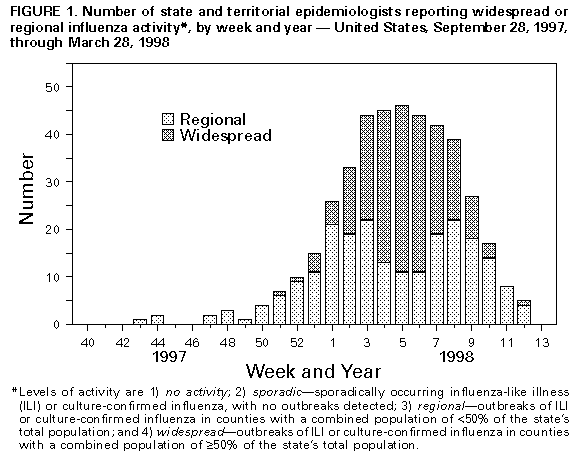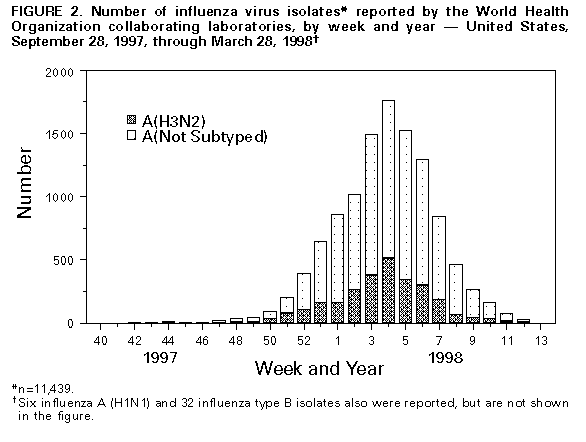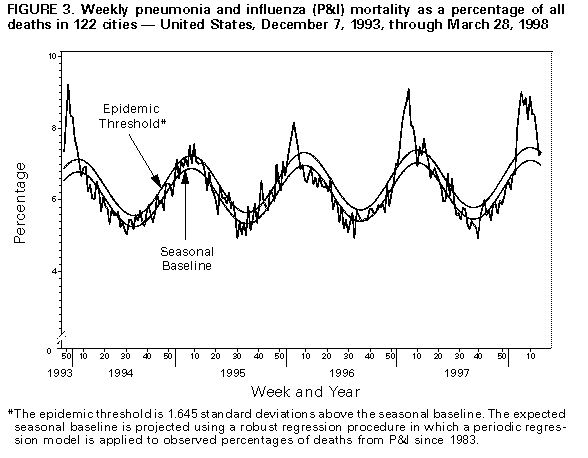 |
|
|
|
|
|
|
| ||||||||||
|
|
|
|
|
|
|
||||
| ||||||||||
|
|
|
|
|
Persons using assistive technology might not be able to fully access information in this file. For assistance, please send e-mail to: mmwrq@cdc.gov. Type 508 Accommodation and the title of the report in the subject line of e-mail. Update: Influenza Activity -- United States and Worldwide, 1997-98 Season, and Composition of the 1998-99 Influenza VaccineIn collaboration with the World Health Organization (WHO), the WHO international network of collaborating laboratories, and state and local health departments, CDC conducts surveillance to monitor influenza activity and to detect antigenic changes in the circulating strains of influenza viruses. This report summarizes surveillance for influenza in the United States and worldwide during the 1997-98 influenza season and describes the composition of the 1998-99 influenza vaccine. United States Influenza activity began to increase in early December 1997 and peaked during late January through early February 1998. The predominant virus was influenza A(H3N2); few influenza type B and influenza A(H1N1) isolates were reported. Each week during the weeks ending January 24 through February 21, 1998, greater than 40 state and territorial epidemiologists reported widespread or regional activity * with peak activity occurring during the week ending February 7 (Figure_1). From September 28, 1997, through March 28, 1998, WHO collaborating laboratories in the United States tested 73,940 specimens for respiratory viruses, and 11,439 (15.5%) were positive for influenza (Figure_2). Of these, 11,407 (99.7%) were influenza type A, and 32 (0.3%) were type B. Among 2799 subtyped influenza type A isolates, 2793 (99.8%) were type A(H3N2), and six (0.2%) were type A(H1N1). Beginning the week ending January 3, the proportion of deaths attributed to pneumonia and influenza (P&I) reported by 122 U.S. cities exceeded the epidemic threshold ** for 10 consecutive weeks. During the week ending March 21, the proportion of deaths attributed to P&I decreased below the threshold, but increased slightly above the threshold for the week ending March 28 (Figure_3). Two related groups of influenza A(H3N2) viruses circulated in the United States this influenza season: A/Wuhan/359/95-like viruses, similar to the strain included in the 1997-98 influenza vaccine, and A/Sydney/5/97-like viruses, a drifted variant of A/Wuhan/359/95. Results from laboratory-confirmed influenza A outbreaks associated with A/Sydney/5/97-like viruses suggest that vaccine containing A/Wuhan/359/95-like virus provided only limited protection (1). Of the 272 influenza A(H3N2) isolates antigenically characterized by CDC, 52 (19%) were similar to A/Wuhan/359/95, and 220 (81%) were similar to A/Sydney/5/97. Among influenza A(H3N2) viruses, the proportion that were A/Sydney/5/97-like increased from 20% (three of 15) in October, to 46% (11 of 24) in November, to 86% (97 of 113) in December, and to 91% (101 of 111) in January. Of the nine characterized influenza A(H3N2) viruses collected in February, eight (78%) were A/Sydney/5/97-like. Eight influenza type B isolates characterized by CDC were similar to the vaccine strain B/Harbin/7/94 and B/Beijing/184/93, and six of seven influenza A(H1N1) isolates were similar to the vaccine strain A/Johannesburg/82/96 and A/Bayern/7/96. One A(H1N1) isolate was characterized as A/Beijing/262/95-like, which is antigenically different from the vaccine strain. Worldwide In the northern hemisphere, during October 1997-March 1998, influenza A(H3N2) predominated in Austria, Canada, Croatia, Denmark, Finland, France, Germany, Greece, Iran, Israel, Italy, Japan, Morocco, Russian Federation, Spain, Sweden, Switzerland, United Kingdom, and the Federal Republic of Yugoslavia. Influenza A(H3N2) also was isolated in Czech Republic, Egypt, Hong Kong, Iceland, Korea, Netherlands, Norway, Poland, Portugal, Romania, Saudi Arabia, and Taiwan. Influenza A(H3N2) activity increased in Iran, Israel, and Japan in early January and in Canada and Europe from late January through February. In the southern hemisphere, during October- December, influenza A(H3N2) viruses were isolated from outbreaks in Argentina, Chile, and Fiji and from sporadic cases in Australia, French Polynesia, and South Africa (2-4). Influenza A(H1N1) isolates were reported less often than influenza A(H3N2) isolates. Outbreaks of influenza A(H1N1) were reported from Belarus, Russian Federation, and United Kingdom. Sporadic cases of influenza A(H1N1) were reported in Argentina, Canada, Croatia, Czech Republic, Denmark, Egypt, France, Germany, Hong Kong, Israel, Italy, Japan, Netherlands, Norway, People's Republic of China, Poland, Portugal, Saudi Arabia, South Africa, Sweden, Switzerland, and Taiwan. Russian Federation and United Kingdom reported increases in influenza A(H1N1) isolates in February, and Germany and Italy reported increases in March (2-4). Outbreaks of influenza B were reported in Japan and People's Republic of China; sporadic cases were reported in Algeria, Argentina, Austria, Belarus, Belgium, Brazil, Canada, Finland, France, Germany, Greece, Hong Kong, Italy, Netherlands, Norway, Portugal, Russian Federation, Senegal, Slovakia, South Africa, Spain, Sweden, Switzerland, United Kingdom, the Federal Republic of Yugoslavia, and Zambia. In May 1997, the first case of influenza A(H5N1) in a human occurred in Hong Kong (5). Seventeen additional cases occurred in Hong Kong in November and December. Despite enhanced surveillance, no new cases have been detected since the end of December. Composition of the 1998-99 Vaccine The Food and Drug Administration's Vaccines and Related Biologic Products Advisory Committee (VRBPAC) recommended that the 1998-99 trivalent vaccine for the United States contain A/Sydney/5/97-like(H3N2), A/Beijing/262/95-like(H1N1), and B/Beijing/184/93-like viruses. This recommendation was based on antigenic analyses of recently isolated influenza viruses. Influenza A(H3N2) isolates were either A/Wuhan/359/95-like or A/Sydney/5/97-like viruses. The proportion of influenza A(H3N2) viruses that were A/Sydney/5/97-like increased from October through March and became predominant in many countries. Vaccine containing an A/Wuhan/359/95-like virus induced a lower antibody response against A/Sydney/5/97 than against A/Wuhan/359/95. Therefore, VRBPAC recommended including A/Sydney/5/97 in the 1998-99 vaccine. A/Bayern/7/95-like viruses, similar to the 1997-98 influenza A(H1N1) vaccine strain, have been the predominant influenza A(H1N1) viruses isolated during the previous year. However, A/Beijing/262/95-like viruses, which have been detected in Asia during the previous 3 years, were identified recently in France, Senegal, South Africa, and the United States. Persons who were vaccinated in an experimental vaccine trial with A/Beijing/262/95 developed equivalent antibody levels against A/Bayern/7/95 and A/Beijing/262/95. However, persons vaccinated with A/Bayern/7/95 had lower antibody levels against A/Beijing/262/95 than A/Bayern/7/95. Because A/Beijing/262/95-like viruses were detected on four continents and because the antibody response to this antigen was more heterogeneous than to A/Bayern/7/95, VRBPAC recommended including A/Beijing/262/95 in the 1998-99 vaccine. Influenza type B isolates from all continents (except Asia) were similar to B/Beijing/184/93 and the 1997-98 vaccine strain B/Harbin/7/94. Viruses antigenically related to the B/Victoria/2/87 reference strain were isolated in Japan and People's Republic of China. Since vaccine containing the B/Harbin/7/94 strain induced antibody to recently isolated B/Beijing/184/93-like strains, VRBPAC recommended retaining B/Harbin/7/94 in the 1998-99 vaccine. Reported by: Participating state and territorial epidemiologists and state public health laboratory directors. A Hay, PhD, National Institute for Medical Research, London; G Schild, DSc, J Wood, PhD, National Institute for Biologic Standards and Control, Hertfordshire, England. I Gust, MD, A Hampson, Commonwealth Serum Laboratories, Parkville, Australia. K Nerome, National Institute of Infectious Diseases, Tokyo, Japan. L Canas, Armstrong Laboratory, Brooks Air Force Base, San Antonio, Texas. Y Guo, Institute of Virology, National Center for Preventive Medicine, Beijing, People's Republic of China. World Health Organization National Influenza Centers, Div of Emerging and Other Communicable Diseases Surveillance and Control, Geneva, Switzerland. Div of Virology, Center for Biologics Evaluation and Research, Food and Drug Administration. Influenza Br, Div of Viral and Rickettsial Diseases, National Center for Infectious Diseases; and an EIS Officer, CDC. Editorial NoteEditorial Note: During the 1997-98 influenza season, influenza A(H3N2) viruses predominated worldwide. This is the second consecutive year in which influenza A(H3N2) viruses have predominated in the United States and the third consecutive year in which the proportion of deaths caused by P&I reported by 122 U.S. cities was elevated for several consecutive weeks. Influenza A(H1N1) and influenza B were isolated only sporadically during the 1997-98 influenza season in most countries, including the United States. However, outbreaks of influenza B were reported in Japan and People's Republic of China. Identification of the A/Sydney/5/97-like(H3N2) and A/Beijing/262/95-like (H1N1) strains and, in Hong Kong, identification of the 18 cases of influenza A(H5N1) illustrate the need for continued international virologic surveillance for influenza and the timely subtyping of influenza A isolates. The production of a vaccine against influenza A(H5N1) for general use was not recommended. However, efforts continue at several laboratories worldwide to develop a vaccine candidate should the need arise, and plans are being developed to test an experimental influenza A(H5N1) vaccine for safety and immunogenicity. Strains to be included in the influenza vaccine usually are selected during the preceding January through February because of scheduling requirements for production, quality control, packaging, distribution, and vaccine administration before onset of the next influenza season. Recommendations of the Advisory Committee on Immunization Practices for the use of vaccine and antiviral agents for prevention and control of influenza will be published in an MMWR Recommendations and Reports on May 1, 1998 (6). References
* Levels of activity are 1) no activity; 2) sporadic -- sporadically occurring influenza-like illness (ILI) or culture-confirmed influenza, with no outbreaks detected; 3) regional -- outbreaks of ILI or culture-confirmed influenza in counties with a combined population of less than 50% of the state's total population; and 4) widespread -- outbreaks of ILI or culture-confirmed influenza in counties with a combined population of greater than or equal to 50% of the state's total population. ** The epidemic threshold is 1.645 standard deviations above the seasonal baseline. The expected seasonal baseline is projected using a robust regression procedure in which a periodic regression model is applied to observed percentages of deaths from P&I since 1983. Figure_1  Return to top. Figure_2  Return to top. Figure_3  Return to top. Disclaimer All MMWR HTML versions of articles are electronic conversions from ASCII text into HTML. This conversion may have resulted in character translation or format errors in the HTML version. Users should not rely on this HTML document, but are referred to the electronic PDF version and/or the original MMWR paper copy for the official text, figures, and tables. An original paper copy of this issue can be obtained from the Superintendent of Documents, U.S. Government Printing Office (GPO), Washington, DC 20402-9371; telephone: (202) 512-1800. Contact GPO for current prices. **Questions or messages regarding errors in formatting should be addressed to mmwrq@cdc.gov.Page converted: 10/05/98 |
|||||||||
This page last reviewed 5/2/01
|